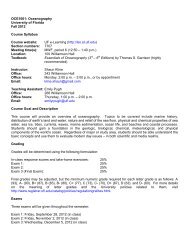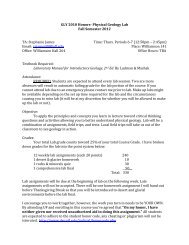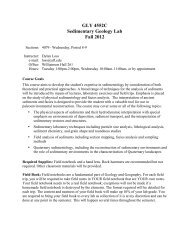Barletta et al 2010.pdf - Department of Geological Sciences ...
Barletta et al 2010.pdf - Department of Geological Sciences ...
Barletta et al 2010.pdf - Department of Geological Sciences ...
You also want an ePaper? Increase the reach of your titles
YUMPU automatically turns print PDFs into web optimized ePapers that Google loves.
F. <strong>Barl<strong>et</strong>ta</strong> <strong>et</strong> <strong>al</strong>. / Quaternary Science Reviews 29 (2010) 2315e2324 2317<br />
Table 2<br />
Radiocarbon date.<br />
Core Depth (cm) Age a (yr BP) C<strong>al</strong>ibrated age b (c<strong>al</strong> BP) Dated materi<strong>al</strong> Lab. number c<br />
2004-804-650 135 4080 40 3580 (3463e3701) Littorina sp. B<strong>et</strong>a-204830<br />
a The age was d<strong>et</strong>ermined by the AMS m<strong>et</strong>hod and corrected for natur<strong>al</strong> and sputtering fractionation (d 13 C ¼ 25& versus Vienna Pee-Dee Belemnite (VPDB)). The<br />
statistic<strong>al</strong> uncertainty <strong>of</strong> the age d<strong>et</strong>ermination is given as one standard deviation (Stuiver and Polach, 1977).<br />
b C<strong>al</strong>ibrated using the on-line CALIB 5.0.2 s<strong>of</strong>tware (Stuiver <strong>et</strong> <strong>al</strong>., 2005) using the Hughen <strong>et</strong> <strong>al</strong>. (2004) marine datas<strong>et</strong>. A tot<strong>al</strong> marine reservoir correction <strong>of</strong> w800 yr was<br />
applied (DR ¼ 400 yr). The first and last ages, in parentheses, represent the 2s c<strong>al</strong> age range.<br />
c B<strong>et</strong>a an<strong>al</strong>ytic Inc., Miami, FL, USA.<br />
(NRM) at peak AF fields <strong>of</strong> 0, 10e60 mT in 5 mT steps, 70 and 80 mT.<br />
In order to d<strong>et</strong>ermine the characteristic remanent magn<strong>et</strong>ization<br />
(ChRM), the magn<strong>et</strong>ic declination and inclination <strong>of</strong> the ChRM<br />
(labelled as ChRM D and ChRM I, respectively) were computed at<br />
1 cm interv<strong>al</strong>s using the standard princip<strong>al</strong> component an<strong>al</strong>ysis<br />
(PCA) <strong>of</strong> Kirschvink (1980) which <strong>al</strong>so provide the maximum<br />
angular deviation (MAD) v<strong>al</strong>ues. MAD v<strong>al</strong>ues lower than 5 are<br />
indicative <strong>of</strong> high-qu<strong>al</strong>ity direction<strong>al</strong> data (e.g., Stoner and St-Onge,<br />
2007). Subsequently, the stepwise acquisition and demagn<strong>et</strong>ization<br />
<strong>of</strong> both the anhyster<strong>et</strong>ic and isotherm<strong>al</strong> remanent magn<strong>et</strong>izations<br />
(indicated as ARM and IRM, respectively) were acquired with the<br />
aim to characterize changes in magn<strong>et</strong>ic miner<strong>al</strong> concentration.<br />
The ARM was imparted using a 100 mT AF field superposed to<br />
a direct current (DC) bias field <strong>of</strong> 50 mT whereas two IRMs were<br />
acquired applying a DC pulse field <strong>of</strong> 0.3 T and 0.95 T<br />
(corresponding to a saturated isotherm<strong>al</strong> remanent magn<strong>et</strong>ization,<br />
SIRM) respectively. These IRMs were used to construct a coercivitydependent<br />
proxy by dividing the IRM at 0.3 T by the SIRM (St-Onge<br />
<strong>et</strong> <strong>al</strong>., 2003). This ratio is useful to estimate changes in magn<strong>et</strong>ic<br />
miner<strong>al</strong>ogy, with v<strong>al</strong>ues close to 1 indicating a low-coercivity<br />
ferrimagn<strong>et</strong>ic miner<strong>al</strong>ogy (e.g., magn<strong>et</strong>ite) and lower v<strong>al</strong>ues indicating<br />
a higher coercivity, possibly antiferromagn<strong>et</strong>ic (e.g., hematite)<br />
miner<strong>al</strong>ogy.<br />
Both the ARM and IRMs were then demagn<strong>et</strong>ized at the same AF<br />
steps as the NRM. The ARM was <strong>al</strong>so expressed as an anhyster<strong>et</strong>ic<br />
susceptibility (k ARM ) by norm<strong>al</strong>izing the ARM with the biasing field.<br />
AF demagn<strong>et</strong>ization data were used to compute the median<br />
destructive fields <strong>of</strong> the NRM, ARM and IRM (labelled as MDF NRM ,<br />
MDF ARM , MDF IRM , respectively; i.e., the v<strong>al</strong>ue <strong>of</strong> the peak AF<br />
necessary to reduce the magn<strong>et</strong>ic remanence to h<strong>al</strong>f <strong>of</strong> its initi<strong>al</strong><br />
Fig. 2. Lithology and magn<strong>et</strong>ic properties <strong>of</strong> Core 650. (A) Illustrated are mean grain size, low-field magn<strong>et</strong>ic susceptibility (k LF ), natur<strong>al</strong> remanent magn<strong>et</strong>ization (NRM),<br />
anhyster<strong>et</strong>ic remanent magn<strong>et</strong>ization (ARM) and isotherm<strong>al</strong> remanent magn<strong>et</strong>ization (IRM) diagrams after an AF demagn<strong>et</strong>ization at 30 mT. Arrows indicate decrease in remanence<br />
intensity with depth (see text for d<strong>et</strong>ails). The only available AMS- 14 C date is <strong>al</strong>so indicated. (B) Magn<strong>et</strong>ic param<strong>et</strong>ers k ARM /k LF , IRM/SIRM and SIRM/k LF against depth. The ratio IRM/<br />
SIRM is c<strong>al</strong>culated after an AF demagn<strong>et</strong>ization level <strong>of</strong> 30 mT in order to emphasize the relative importance <strong>of</strong> the high-coercivity component. The gray shaded area indicates the<br />
interv<strong>al</strong> used for PSV and RPI reconstructions.







